Pengcheng Wu
NTU
Laplacian Analysis Meets Dynamics Modelling: Gaussian Splatting for 4D Reconstruction
Aug 07, 2025Abstract:While 3D Gaussian Splatting (3DGS) excels in static scene modeling, its extension to dynamic scenes introduces significant challenges. Existing dynamic 3DGS methods suffer from either over-smoothing due to low-rank decomposition or feature collision from high-dimensional grid sampling. This is because of the inherent spectral conflicts between preserving motion details and maintaining deformation consistency at different frequency. To address these challenges, we propose a novel dynamic 3DGS framework with hybrid explicit-implicit functions. Our approach contains three key innovations: a spectral-aware Laplacian encoding architecture which merges Hash encoding and Laplacian-based module for flexible frequency motion control, an enhanced Gaussian dynamics attribute that compensates for photometric distortions caused by geometric deformation, and an adaptive Gaussian split strategy guided by KDTree-based primitive control to efficiently query and optimize dynamic areas. Through extensive experiments, our method demonstrates state-of-the-art performance in reconstructing complex dynamic scenes, achieving better reconstruction fidelity.
Self-Bootstrapping for Versatile Test-Time Adaptation
Apr 10, 2025Abstract:In this paper, we seek to develop a versatile test-time adaptation (TTA) objective for a variety of tasks - classification and regression across image-, object-, and pixel-level predictions. We achieve this through a self-bootstrapping scheme that optimizes prediction consistency between the test image (as target) and its deteriorated view. The key challenge lies in devising effective augmentations/deteriorations that: i) preserve the image's geometric information, e.g., object sizes and locations, which is crucial for TTA on object/pixel-level tasks, and ii) provide sufficient learning signals for TTA. To this end, we analyze how common distribution shifts affect the image's information power across spatial frequencies in the Fourier domain, and reveal that low-frequency components carry high power and masking these components supplies more learning signals, while masking high-frequency components can not. In light of this, we randomly mask the low-frequency amplitude of an image in its Fourier domain for augmentation. Meanwhile, we also augment the image with noise injection to compensate for missing learning signals at high frequencies, by enhancing the information power there. Experiments show that, either independently or as a plug-and-play module, our method achieves superior results across classification, segmentation, and 3D monocular detection tasks with both transformer and CNN models.
Continual Optimization with Symmetry Teleportation for Multi-Task Learning
Mar 06, 2025



Abstract:Multi-task learning (MTL) is a widely explored paradigm that enables the simultaneous learning of multiple tasks using a single model. Despite numerous solutions, the key issues of optimization conflict and task imbalance remain under-addressed, limiting performance. Unlike existing optimization-based approaches that typically reweight task losses or gradients to mitigate conflicts or promote progress, we propose a novel approach based on Continual Optimization with Symmetry Teleportation (COST). During MTL optimization, when an optimization conflict arises, we seek an alternative loss-equivalent point on the loss landscape to reduce conflict. Specifically, we utilize a low-rank adapter (LoRA) to facilitate this practical teleportation by designing convergent, loss-invariant objectives. Additionally, we introduce a historical trajectory reuse strategy to continually leverage the benefits of advanced optimizers. Extensive experiments on multiple mainstream datasets demonstrate the effectiveness of our approach. COST is a plug-and-play solution that enhances a wide range of existing MTL methods. When integrated with state-of-the-art methods, COST achieves superior performance.
Audio-Reasoner: Improving Reasoning Capability in Large Audio Language Models
Mar 04, 2025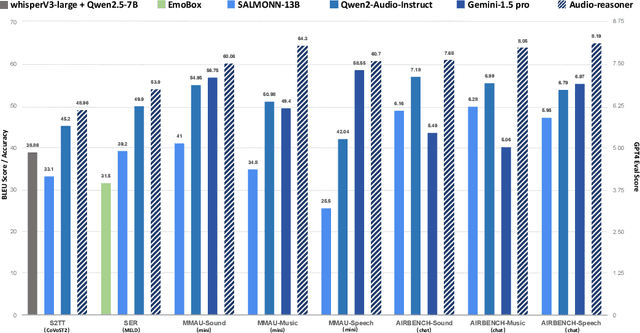
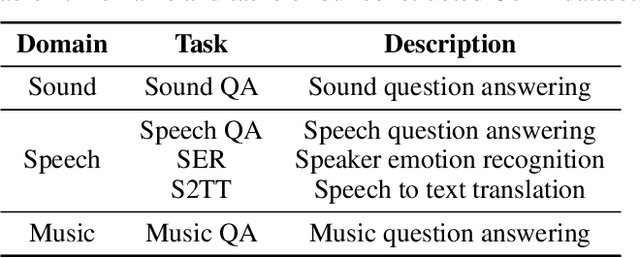
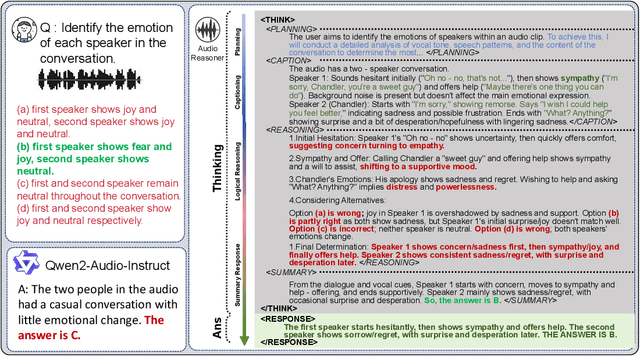

Abstract:Recent advancements in multimodal reasoning have largely overlooked the audio modality. We introduce Audio-Reasoner, a large-scale audio language model for deep reasoning in audio tasks. We meticulously curated a large-scale and diverse multi-task audio dataset with simple annotations. Then, we leverage closed-source models to conduct secondary labeling, QA generation, along with structured COT process. These datasets together form a high-quality reasoning dataset with 1.2 million reasoning-rich samples, which we name CoTA. Following inference scaling principles, we train Audio-Reasoner on CoTA, enabling it to achieve great logical capabilities in audio reasoning. Experiments show state-of-the-art performance across key benchmarks, including MMAU-mini (+25.42%), AIR-Bench chat/foundation(+14.57%/+10.13%), and MELD (+8.01%). Our findings stress the core of structured CoT training in advancing audio reasoning.
HDT: Hierarchical Discrete Transformer for Multivariate Time Series Forecasting
Feb 12, 2025Abstract:Generative models have gained significant attention in multivariate time series forecasting (MTS), particularly due to their ability to generate high-fidelity samples. Forecasting the probability distribution of multivariate time series is a challenging yet practical task. Although some recent attempts have been made to handle this task, two major challenges persist: 1) some existing generative methods underperform in high-dimensional multivariate time series forecasting, which is hard to scale to higher dimensions; 2) the inherent high-dimensional multivariate attributes constrain the forecasting lengths of existing generative models. In this paper, we point out that discrete token representations can model high-dimensional MTS with faster inference time, and forecasting the target with long-term trends of itself can extend the forecasting length with high accuracy. Motivated by this, we propose a vector quantized framework called Hierarchical Discrete Transformer (HDT) that models time series into discrete token representations with l2 normalization enhanced vector quantized strategy, in which we transform the MTS forecasting into discrete tokens generation. To address the limitations of generative models in long-term forecasting, we propose a hierarchical discrete Transformer. This model captures the discrete long-term trend of the target at the low level and leverages this trend as a condition to generate the discrete representation of the target at the high level that introduces the features of the target itself to extend the forecasting length in high-dimensional MTS. Extensive experiments on five popular MTS datasets verify the effectiveness of our proposed method.
Test-Time Model Adaptation with Only Forward Passes
Apr 02, 2024



Abstract:Test-time adaptation has proven effective in adapting a given trained model to unseen test samples with potential distribution shifts. However, in real-world scenarios, models are usually deployed on resource-limited devices, e.g., FPGAs, and are often quantized and hard-coded with non-modifiable parameters for acceleration. In light of this, existing methods are often infeasible since they heavily depend on computation-intensive backpropagation for model updating that may be not supported. To address this, we propose a test-time Forward-Only Adaptation (FOA) method. In FOA, we seek to solely learn a newly added prompt (as model's input) via a derivative-free covariance matrix adaptation evolution strategy. To make this strategy work stably under our online unsupervised setting, we devise a novel fitness function by measuring test-training statistic discrepancy and model prediction entropy. Moreover, we design an activation shifting scheme that directly tunes the model activations for shifted test samples, making them align with the source training domain, thereby further enhancing adaptation performance. Without using any backpropagation and altering model weights, FOA runs on quantized 8-bit ViT outperforms gradient-based TENT on full-precision 32-bit ViT, while achieving an up to 24-fold memory reduction on ImageNet-C. The source code will be released.
Evolutionary Reinforcement Learning: A Systematic Review and Future Directions
Feb 20, 2024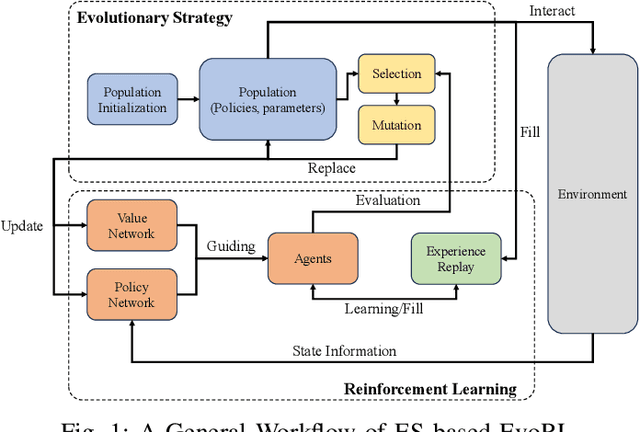

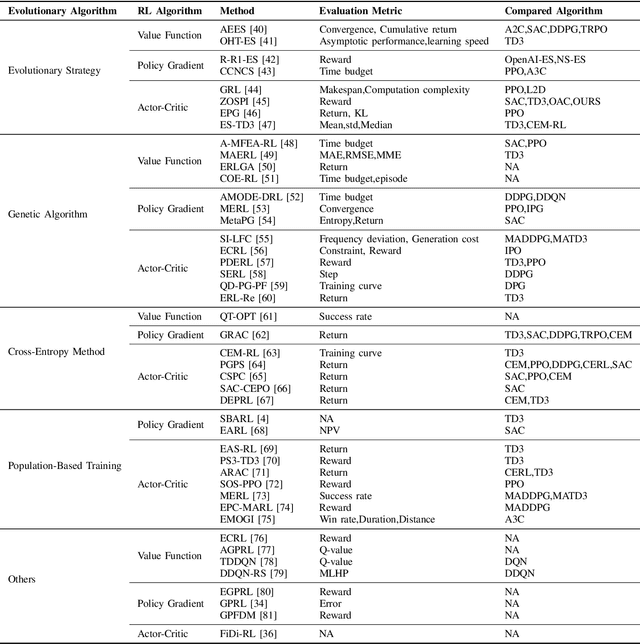

Abstract:In response to the limitations of reinforcement learning and evolutionary algorithms (EAs) in complex problem-solving, Evolutionary Reinforcement Learning (EvoRL) has emerged as a synergistic solution. EvoRL integrates EAs and reinforcement learning, presenting a promising avenue for training intelligent agents. This systematic review firstly navigates through the technological background of EvoRL, examining the symbiotic relationship between EAs and reinforcement learning algorithms. We then delve into the challenges faced by both EAs and reinforcement learning, exploring their interplay and impact on the efficacy of EvoRL. Furthermore, the review underscores the need for addressing open issues related to scalability, adaptability, sample efficiency, adversarial robustness, ethic and fairness within the current landscape of EvoRL. Finally, we propose future directions for EvoRL, emphasizing research avenues that strive to enhance self-adaptation and self-improvement, generalization, interpretability, explainability, and so on. Serving as a comprehensive resource for researchers and practitioners, this systematic review provides insights into the current state of EvoRL and offers a guide for advancing its capabilities in the ever-evolving landscape of artificial intelligence.
A Comprehensive Survey on Deep Learning Techniques in Educational Data Mining
Sep 09, 2023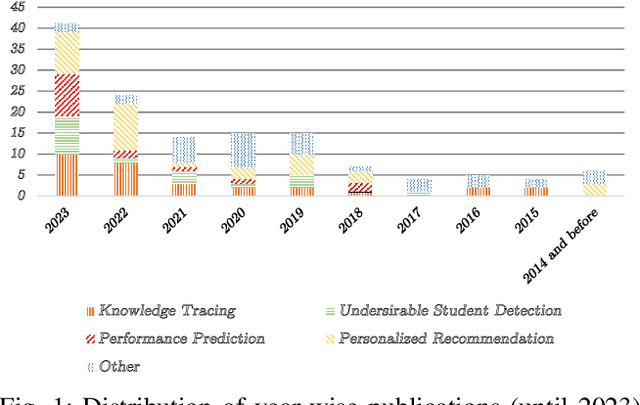
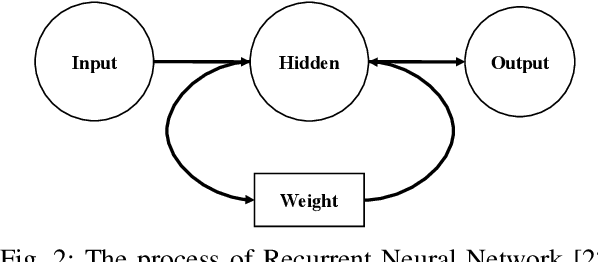
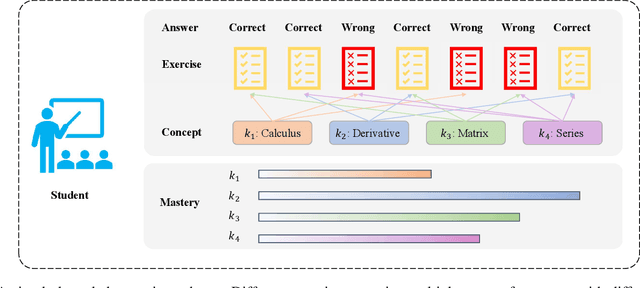
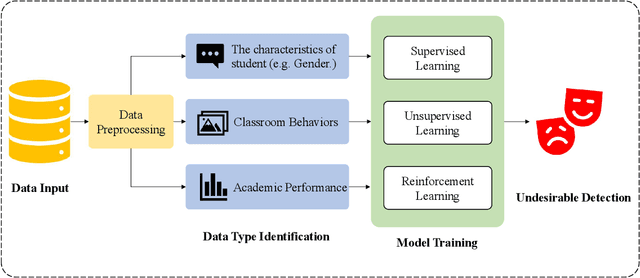
Abstract:Educational Data Mining (EDM) has emerged as a vital field of research, which harnesses the power of computational techniques to analyze educational data. With the increasing complexity and diversity of educational data, Deep Learning techniques have shown significant advantages in addressing the challenges associated with analyzing and modeling this data. This survey aims to systematically review the state-of-the-art in EDM with Deep Learning. We begin by providing a brief introduction to EDM and Deep Learning, highlighting their relevance in the context of modern education. Next, we present a detailed review of Deep Learning techniques applied in four typical educational scenarios, including knowledge tracing, undesirable student detecting, performance prediction, and personalized recommendation. Furthermore, a comprehensive overview of public datasets and processing tools for EDM is provided. Finally, we point out emerging trends and future directions in this research area.
Convex Approximation for Probabilistic Reachable Set under Data-driven Uncertainties
Mar 02, 2023Abstract:This paper is proposed to efficiently provide a convex approximation for the probabilistic reachable set of a dynamic system in the face of uncertainties. When the uncertainties are not limited to bounded ones, it may be impossible to find a bounded reachable set of the system. Instead, we turn to find a probabilistic reachable set that bounds system states with confidence. A data-driven approach of Kernel Density Estimator (KDE) accelerated by Fast Fourier Transform (FFT) is customized to model the uncertainties and obtain the probabilistic reachable set efficiently. However, the irregular or non-convex shape of the probabilistic reachable set refrains it from practice. For the sake of real applications, we formulate an optimization problem as Mixed Integer Nonlinear Programming (MINLP) whose solution accounts for an optimal $n$-sided convex polygon to approximate the probabilistic reachable set. A heuristic algorithm is then developed to solve the MINLP efficiently while ensuring accuracy. The results of comprehensive case studies demonstrate the near-optimality, accuracy, efficiency, and robustness enjoyed by the proposed algorithm. The benefits of this work pave the way for its promising applications to safety-critical real-time motion planning of uncertain systems.
Efficient Training of Large-scale Industrial Fault Diagnostic Models through Federated Opportunistic Block Dropout
Feb 22, 2023Abstract:Artificial intelligence (AI)-empowered industrial fault diagnostics is important in ensuring the safe operation of industrial applications. Since complex industrial systems often involve multiple industrial plants (possibly belonging to different companies or subsidiaries) with sensitive data collected and stored in a distributed manner, collaborative fault diagnostic model training often needs to leverage federated learning (FL). As the scale of the industrial fault diagnostic models are often large and communication channels in such systems are often not exclusively used for FL model training, existing deployed FL model training frameworks cannot train such models efficiently across multiple institutions. In this paper, we report our experience developing and deploying the Federated Opportunistic Block Dropout (FEDOBD) approach for industrial fault diagnostic model training. By decomposing large-scale models into semantic blocks and enabling FL participants to opportunistically upload selected important blocks in a quantized manner, it significantly reduces the communication overhead while maintaining model performance. Since its deployment in ENN Group in February 2022, FEDOBD has served two coal chemical plants across two cities in China to build industrial fault prediction models. It helped the company reduce the training communication overhead by over 70% compared to its previous AI Engine, while maintaining model performance at over 85% test F1 score. To our knowledge, it is the first successfully deployed dropout-based FL approach.
 Add to Chrome
Add to Chrome Add to Firefox
Add to Firefox Add to Edge
Add to Edge